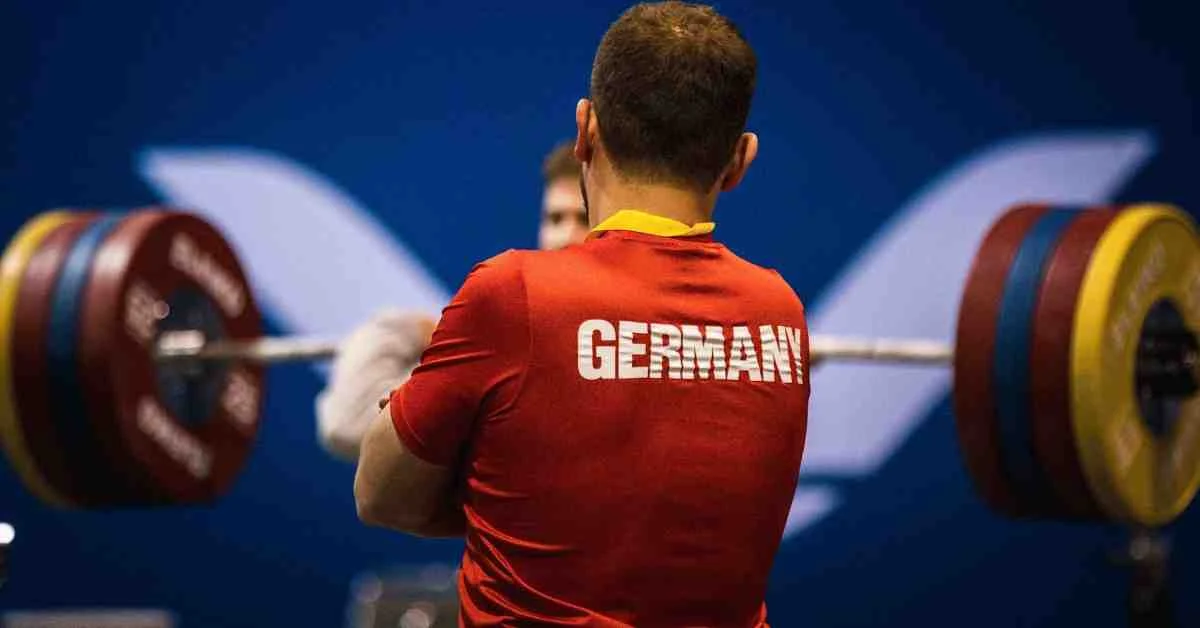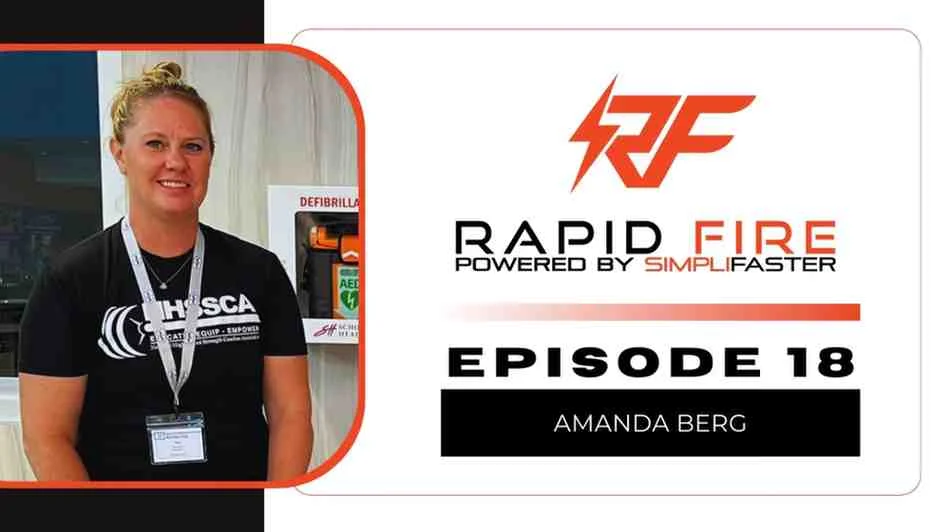Introduction
NFL Combine training has exploded recently. It was not too long ago that most college football players stayed at their school and trained with their college strength coach to prepare for the NFL Combine or their respective college pro days. The combine and pro days are used to showcase the athleticism of the players to help NFL coaches and scouts better make decisions on who they should draft to their team. Most of these tests are familiar ones, such as the vertical jump, broad jump, 225 bench press, and of course the 40-yard dash, as well as a few other performance tests and position drills.
For potential future NFL players, the importance of this all comes down to how much money rookies can make in their first contracts. Obviously, the higher they are drafted, the more money they will make. Training for the NFL Combine and pro days is all about maximizing their performance in these tests, especially the 40-yard dash. For many of you reading this, this article can also be used as a cheat sheet for how you can help your high school athletes nail their performance at college camps.
While I’ve had five years of experience with combine athletes at Bommarito Performance Systems in Miami, FL, 2025 was my first year of coaching this training on my own. I was able to work with five athletes and help them through this process. All of these players went to smaller schools, ranging from NAIA and Division 3 to FCS and Division 1 G5. The good news for you is that this means I was working with athletes similar to those many of you work with at your schools, not genetic freaks that would get better doing just about anything.
Since all of these guys went to a smaller school and/or were undersized, they really had to overperform and prove themselves. Performing well at their college pro day was their only chance at playing in the NFL or really any high level of professional football. They were all good players with impressive statistics and accolades, but that doesn’t always cut it for the NFL.
First, I’ll take you through an overview of my training philosophy to help make sense of the speed and strength workouts I go over later.
The Science of Sprinting
There are 3 components to sprinting.
- Relative force production
- The speed at which force is applied
- The direction that force is applied
Producing high amounts of relative force is a prerequisite. This is what is needed to even think about running fast. Elite track sprinters produce ground reactive forces that are 4-5 times their body weight with each stride. The amount of force is not the limiting factor in high level sprinters. We know this because exercises like single leg hopping produce higher levels of force, but not the same speeds as sprinting1.
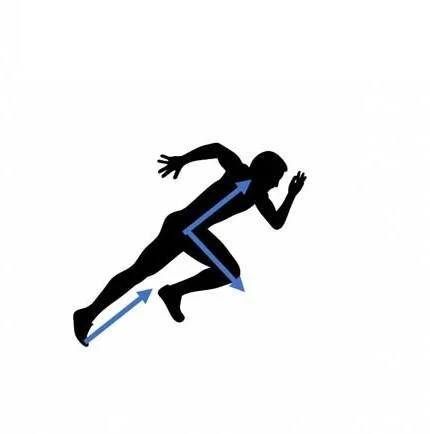
Image: Illustration of horizontal and vertical forces needed in acceleration. Fitzpatrick et al.2
In sprinting, the athlete needs enough vertical force to keep them upright and not crash to the ground, and give them sufficient flight time to reposition their legs and strike the ground again. In elite sprinters, this flight time is around .13 seconds3. After enough force is applied vertically, the rest of the force can be applied horizontally to push them forward.
This helps us split training into focusing on either acceleration or max velocity sprinting. Acceleration is characterized by a more aggressive forward lean, more aggressive shin angle, and longer ground contact times. This is when athletes need to push and propel themselves forward. Per Newton’s First Law, the athlete is in a static starting position (at rest). In order to begin moving, they need to provide sufficient force to move their body. The first step of the 40-yard dash will have the highest amount of horizontal force. Each following step will have progressively less and less horizontal force until they reach maximum velocity.
Max velocity sprinting has the characteristics of a more upright posture, more vertical shin angle at ground contact, and shorter ground contact times. The majority of force expressed at max velocity is vertical. The horizontal forces applied at max velocity are about .75 times body weight, compared to the 4-5 times body weight of total force4.
Again, the total amount of relative force applied is typically not the limiting factor, especially at the elite levels. This is because as sprinting speeds increase, ground contact times decrease. Athletes have less time to express force. Elite sprinters can have ground contact times around .08s. Meaning a 200 pound sprinter can produce 800-1,000 pounds of force in .08s, or the length of time of the average blink.
Just to be clear—high levels of relative force are still a prerequisite. These forces are needed to keep the athlete upright and to propel them forward. However, two of the main limiting factors in speed are whether or not you are able to produce the necessary amount of force in a shorter period of time (ground contact time) and the direction at which you are applying the force. This is highlighted in a study conducted by JB Morin about the importance of the direction of force in sprinting speed5.
This study found that maintaining a high proportion of horizontal force was a key predictor in sprinting speed. How do we do this?
- Produce high levels of relative force in a short period of time. The vertical aspect is always going to take what it needs to keep the athlete from falling and to provide sufficient flight time.
- Improving sprint mechanics.
- By repositioning the leg efficiently and in a better position, the athlete can direct the force more horizontally for longer.
- A better technical model will lead to less energy leaks which will allow for more force to be applied horizontally.
Think of a sneaker business. Businesses want profit. The sneakers cost a set amount to make and produce. It is a fact of the business, you have to pay for the product to be made. Profits can be increased by charging more money for the sneakers or by lowering the cost to produce the sneakers by becoming more efficient in production.
This is the same with sprinting. The cost of vertical force is unavoidable – it’s always going to be there.. The athlete can generate more horizontal force if they can more quickly apply the needed vertical force, or if they can efficiently reposition their leg during the flight phase to direct the force horizontally on the next step. We will see what this should look like and how to drill it in a second.
Science of Jumping
The components of jumping are the same as that of sprinting.
- Relative force production
- The speed at which force is applied
- The direction that force is applied
Athletes need to produce high levels of relative force in a short period of time and in the proper direction. Vertical jump height comes down to takeoff velocity. The faster an athlete is moving at the moment of takeoff, the higher they are going to jump. (Broad jump performance is largely the same, but you have to consider other variables like the direction of force and landing strategies more.) So, what influences takeoff velocity? Impulse. Impulse is the change in momentum of an object. More simply, it is the product of force and time. Looking at the image below of a force time curve, impulse is the total area underneath the curve. Impulse and velocity are directly related to each other.
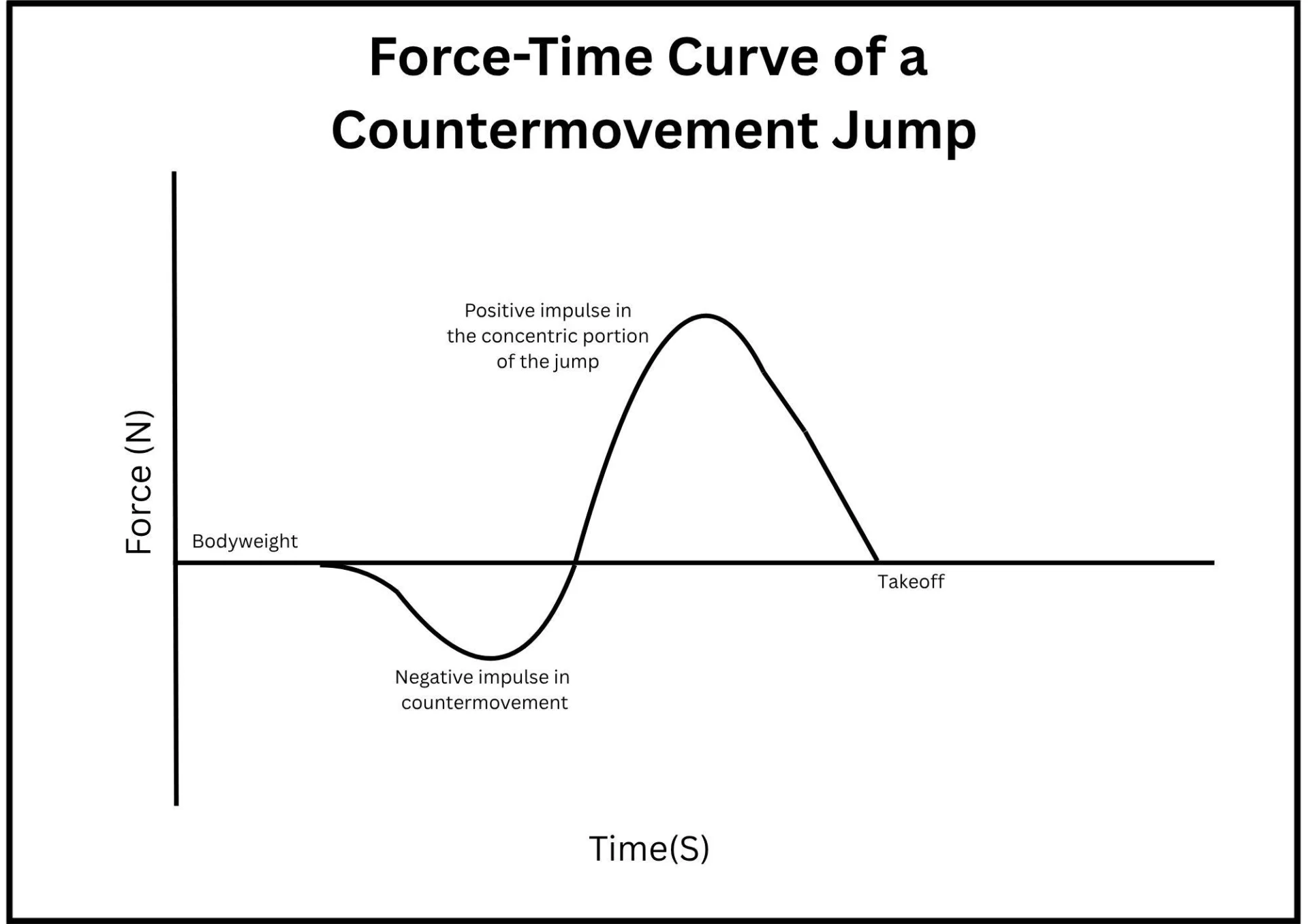
Image 2: Illustration of impulse taken from Brady et al.6. Positive impulse is the total amount of concentric force.
How do you create more impulse?
- Reach a higher peak force output
- Reach the peak force output quicker
- Apply the force for a longer period of time
The good news is that the critical traits needed for sprinting and jumping are very similar – high forces applied quickly in the right direction. So how do we train for this? Thinking back to Exercise Science 101, remember neurological adaptations to strength training? The main neurological adaptations are improved motor unit recruitment, rate coding, intramuscular coordination, and intermuscular coordination.
Motor unit recruitment and intramuscular coordination can improve from high intensity, high effort movements in the weight room. Rate coding can improve from high velocity movements. Intermuscular coordination will improve from performing the specific task, which are sprinting and jumping in this case. This was the foundation of the training program. Now that we’ve gone over the key traits we wanted to train and the technical changes we were looking for, we can dive into the program. I’ll walk you through exactly how I approached our 8 weeks of training, and how each piece addressed our goals.
The good news is that the critical traits needed for sprinting and jumping are very similar – high forces applied quickly in the right direction, says @Steve20Haggerty Share on XThe Program
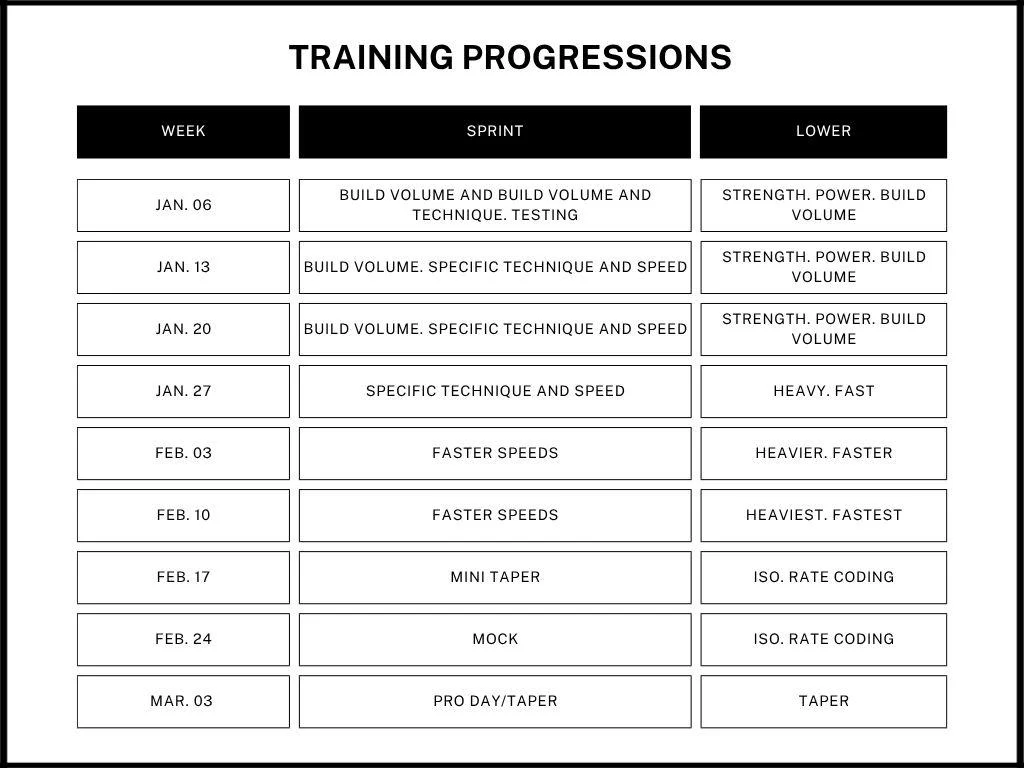
Image 3: Chart of training progressions
Here is the training outline. These concepts provide a framework and direction for the training. For week 1, we performed baseline testing to see where they were at initially. Dashr’s timing gates allow us to track each 10-yard split of the sprint. This also gives us a better picture of where they were already strong and where their biggest opportunities for improvement were. For pretesting, I do not have them run a full 40 yards. It is just too dangerous and not worth it to me. I had them run a 30-yard sprint and estimated the 40-time based on their splits. From there I needed to slowly ramp up sprinting volume to allow them to raise intensity in the coming weeks, and eventually taper and peak. Much of the sprinting volume was shorter distances and supplemented with basic sprint drills. Sprint drills do not replace sprinting, but they can be useful for exposing the tissues of the lower leg to specific ranges of motion, speeds, and ground contacts.
For the lower body lifting, our focus was strength and power. Just like with the sprint work, we needed to accumulate volume first in order to withstand higher intensities later in the training. As you will see below, the focus with heavy work was mainly split squats, and for speed work we used speed squats. As the program progressed, the guys used heavier weights each week on split squats and faster bar speeds on speed squats. Eventually working into maximal isometric pushes for high levels of motor unit recruitment.
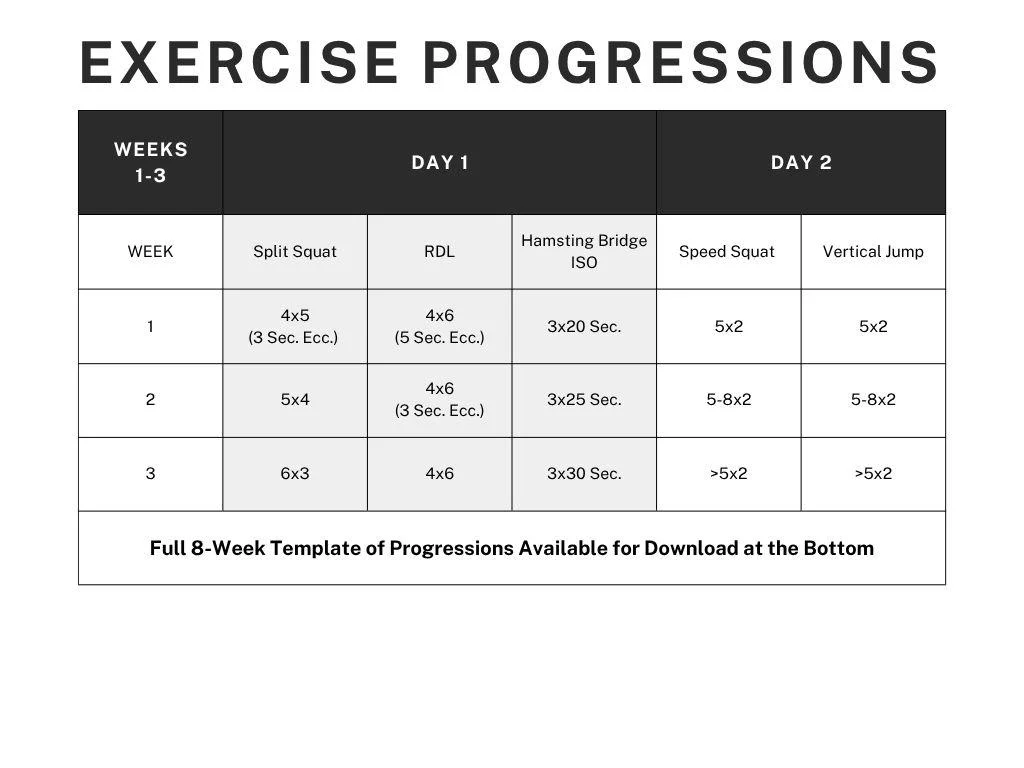
Image: First three weeks of lower body lifting progressions
Letting Autoregulation Guide Our Training
Autoregulation is a training principle that allows the volume and load of an exercise to fluctuate based on individual performance. For example, we used OVR to perform speed squats at 1.0 m/s for 2 reps and then 2 reps of vertical jumps. How much weight they use on the bar is dictated by their bar speed – if moving faster than 1.0 m/s then we add weight, if moving slower than the prescribed speed then we lower the weight. How many sets they perform is based on how well they are maintaining their bar speed and jump height. In this scenario, they all had a minimum of 5 sets, mainly to establish a baseline jump height and find the appropriate weight on the bar. From here, as long as they can maintain the bar speed and jump height then we keep going. One athlete might be especially fatigued from a bad night of sleep and performance drops in set 6 or 7, then they move on to accessories. Another athlete hit a personal record on vertical jump on set 8, so we keep going until they drop off.
This way I am not prescribing volume for the whole group or guessing on what each athlete needs. Their performance for that day will dictate how much they can do. My job is then to motivate them to get in as much work as possible. We want to push the limit as far as possible. Once their output drops off, we know we have sufficiently squeezed out as much juice as we could for the day.
Using technology to track bar speed improves the training session in multiple ways. One, it motivates the athlete. The feedback gives them an incentive to move the bar as fast as possible and compete against the athletes around them. This also gives them immediate feedback on how well they are doing7. Two, it makes autoregulation easy. We don’t have to worry about their ability to accurately gauge RPE. Simply, If the speed drops 5%, then it’s time to move on to accessory movements.
This way I am not prescribing volume for the whole group or guessing on what each athlete needs. Their performance for that day will dictate how much they can do, says @Steve20Haggerty on autoregulation Share on XPutting it All Together
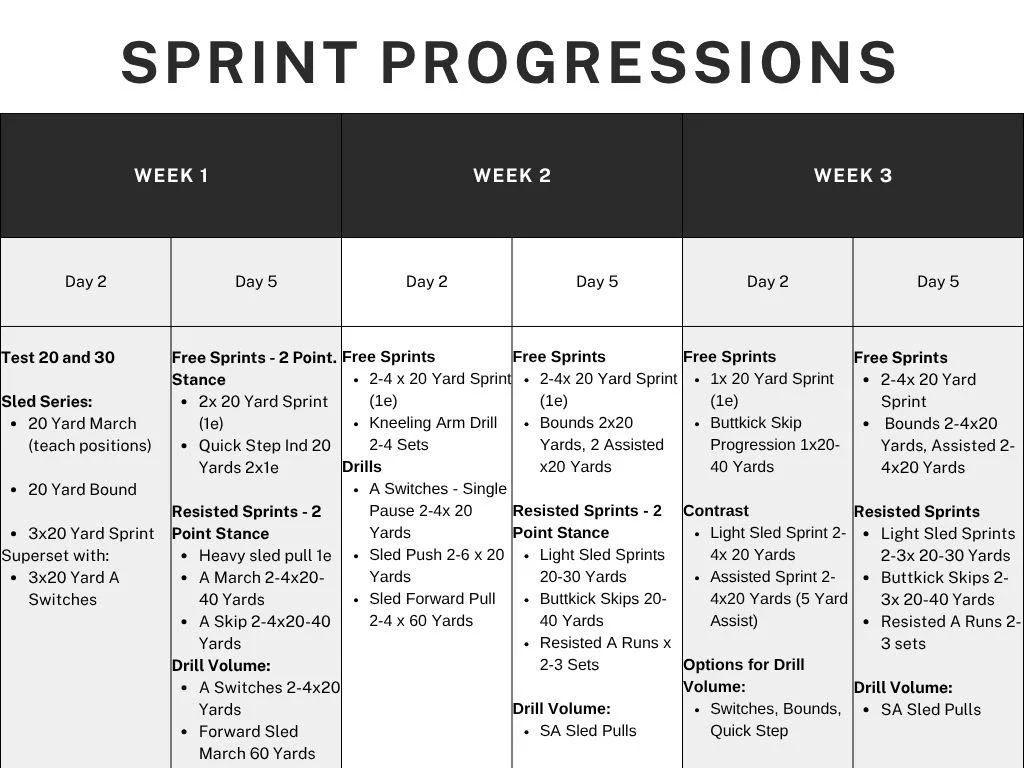
Image: First three weeks of the sprint program. All 8 weeks, in addition to all of the lifting progressions, can be downloaded at the bottom of this article
The image above shows the entire speed program over the course of 8 weeks, except working on the 40-yard dash stance and starts which was done on the same days as the agility drills. The standard format of every sprint workout included a warmup, timing sprints of some sort – typically 10-20 yard splits, followed by either resisted sprints or contrast sprints, and finishing with volume work. The volume work was either specific drills for each individual based on what was determined they need to improve on from a technical standpoint, or variations of sled walking. The sprint drills typically focused on posture, hip flexion, or thigh split and attacking the ground – we used A switches, quick steps, or bounds to work on these. The sled pulls were either walking forward to emphasize hip extension, walking forward with the belt around one shoulder to emphasize hip extension and anti-rotation, or walking lateral for hip abduction and lateral ankle mobility.
As the weeks progressed the athletes went from heavy resisted sprints to lighter resisted sprints and finally to more assisted sprints, which falls in line with the image of the outline. We wanted to work towards higher velocities as the weeks progressed. Starting in week 6, there were 2 options for the contrast section. Depending on how well the timed sprints went for individual athletes determined if they used heavier resisted sprints or assisted sprints for that day. If the athlete was running slower than previously, then they would perform the heavy and light sled contrast. If the athlete was having a fast day and their nervous system was prepared for higher velocities, then we would perform light resisted sprints with assisted sprints. The volume of the resisted and contrast work was based around how they were feeling, how the sprints looked technically, and how close they were to their pro day.
Results
Finally, how did the athletes actually perform? These results blew me away. The group average for the 40-yard dash improved by 0.44 seconds. The industry average I am familiar with is right around 0.30 seconds, while this group’s worst improvement was 0.30 seconds. The broad jump and vertical jump follow similar trends of having huge increases in performance.
Naturally, there were some improvements from simple technical changes like learning a 3-point stance and reaching the feet out in front when landing a broad jump. The majority of the performance improvements came from their ability to produce more force and produce force faster. We were able to track this by testing RSI (reactive strength index), peak concentric power on the vertical jump, and sprint-specific isometrics – all of which improved over the course of training.
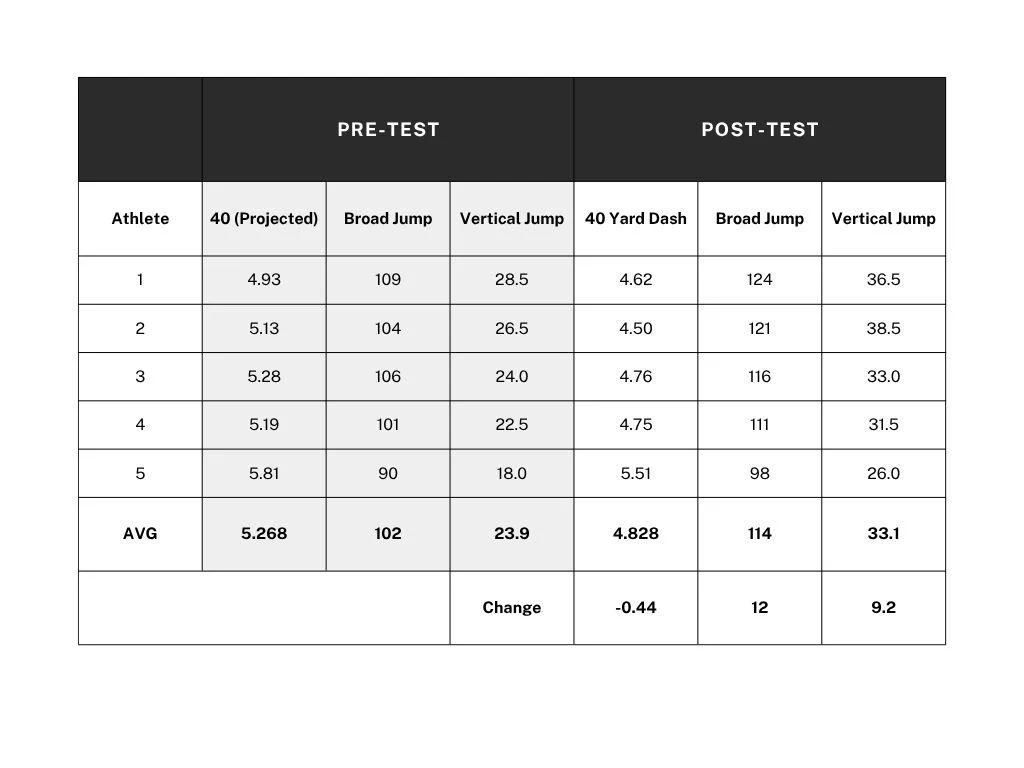
Image: Pre-test vs. post-test results (each row represents one of the athletes, with the bottom row in bold being the group average)
Keep in mind that this training program was specific to the NFL Combine performance tests, not actually improving in sport. While I believe every athlete’s training should still be focused more on producing more relative force and producing force faster, obviously the training should still make sure they’re able to meet the demands of their sport and prepare the tissue for the movements they will experience. But if you’re only focused on helping an athlete prepare for a camp or combine, then following a similar guide to the one I have laid out should lead to significant improvements in athletic performance.
Want the full 8-Week Plan for Lifting and Sprint Progressions? Click below to download a PDF of the full training plan.
References
- Weyand PG, Sandell RF, Prime DN, Bundle MW. The biological limits to running speed are imposed from the ground up. J Appl Physiol (1985). 2010 Apr;108(4):950-61.
- Fitzpatrick, D.A., Cimadoro, G., and Cleather, D.J. “The Magical Horizontal Force Muscle? A Preliminary Study Examining the ‘Force-Vector’ Theory.” Sports. 2019;7:30.
- Čoh, Milan & Hébert-Losier, Kim & Štuhec, Stanislav & Babić, Vesna & Supej, Matej. (2018). Kinematics of Usain Bolt’s maximal sprint velocity. Kinesiology. 50. 100-101. 10.26582/k.50.2.10.
- Kuitunen S, Komi PV, Kyröläinen H. Knee and ankle joint stiffness in sprint running. Med Sci Sports Exerc. 2002 Jan;34(1):166-73.
- MORIN, JEAN-BENOÎT; EDOUARD, PASCAL; SAMOZINO, PIERRE. Technical Ability of Force Application as a Determinant Factor of Sprint Performance. Medicine & Science in Sports & Exercise 43(9):p 1680-1688, September 2011.
- Brady, C. et al. “Focus of Attention for Diagnostic Testing of the Force-Velocity Curve.” Strength & Conditioning Journal. 2017;39:57-70.
- Randell AD, Cronin JB, Keogh JW, Gill ND, Pedersen MC. Effect of instantaneous performance feedback during 6 weeks of velocity-based resistance training on sport-specific performance tests. J Strength Cond Res. 2011 Jan;25(1):87-93.





